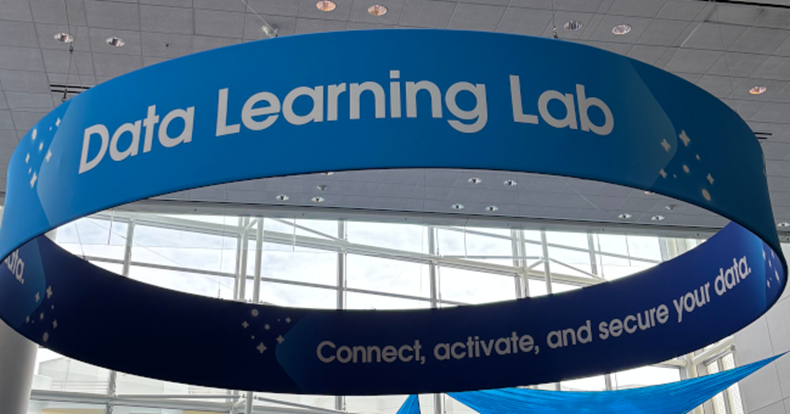From the Main Stage to the Pipeline: Key Takeaways from Dreamforce 2025
- Harrison Gore

- Oct 24
- 6 min read

Chris Carney:
Another year, another Dreamforce in the books. I went into my 7th Dreamforce thinking it would be my last. For the uninitiated, it can be quite overwhelming. Between the travel, the masses of people, and the sheer volume of content I thought going in that this might finally be the year that the hassle of Dreamforce outweighed the benefits of attending – I was quickly proven wrong.
As seasoned Dreamforce veterans at this point, the Paciolan admin team did a phenomenal job dividing up topics to make sure that we collectively took in all that Dreamforce had to offer. Even more so than in past years, AI (specifically Agentforce) was the preeminent topic. Every single session at the conference included some reference to AI and how it was already reshaping work done on that topic or how it would in the near future. Slack was another Salesforce product that found its way into almost every session. My biggest takeaway this year was Salesforce’s attempt at building a sports specific user group this year. I went to a live sports roundtable session that included teams from the NBA, MLB, NFL, MLS, NHL and other sport related industries. This is something Salesforce piloted in Europe and is looking to bring to their US customers. I’m excited to participate in the future and be a voice for all of our college athletics customers!
Andrew Campbell:
Each Year, Dreamforce reenergizes me with a new appreciation for a well-structured Salesforce Org. This year, a standout theme was not any new product or feature (although if you guessed AI being central to all new products, you would be correct) but rather a concept: data hygiene. Clean and accurate data has always been an operational best-practice, but in the growing world of LLMs sifting through every kilobyte of data available, hygiene has never been more important.

One of my favorite sessions, Conquering Data Quality Blues, broke governance down into two components: people and process. It’s not enough to simply run a data cleanup once a year, and purge or correct inaccurate data. Rather, the most successful organizations have a dedicated governance team responsible for ongoing standards of quality. I look forward to implementing the idea of a governance team internally at Paciolan and would encourage you to think about the same for your organizations.
Another key takeaway came from the Decluttering Your Org session. I learned (or perhaps was reminded) that metadata hygiene is just as critical as data hygiene. Confusing field labels, field names, poorly worded or missing help text or any number of ways to poorly maintain metadata can confuse and frustrate end Users and Admins. This year, I am making it a personal goal to enrich our metadata with proper descriptions and help text as well as clearing out old unused fields across the entire Org. This should net only positive returns for our end Users.
Overall, I left motivated to map out our own internal plan for an annual “technical health review” to keep our org efficient and sustainable. I look forward to implementing an ongoing data governance strategy to keep our own data clean and reliable. I hope some of these insights on data hygiene will encourage my clients to take a more proactive approach with their own data maintenance. The payoff isn’t just a cleaner Salesforce; it’s a stronger, faster, and more trustworthy foundation for every part of the business.
Joseph Regalado:
Within the last couple of years Salesforce has announced the eventual phase out of defining a user’s permissions through profiles and announced that permission sets would be the future. The goal is to simplify the user management process. However, there are a lot of established Salesforce orgs with lots of existing profiles and permission sets, many of which may be duplicates or not being used by anyone. This has likely created a mess that ultimately will need to be cleaned up with the changes Salesforce has proposed. This year at Dreamforce, Salesforce announced some new user management features that should help the admins out there tasked with these cleanup efforts and will hopefully help make the transition process smoother.
The concept of user comparisons stood out to me as this has historically been a pain point, especially when being asked why one user can see something in Salesforce while another user cannot. Admins will soon be able to ask Salesforce to run a comparison between users to see where their access levels are different and ultimately how you can correct the issue. This could be a big win as the alternative is to go through multiple different areas of your org’s setup page to find where the differences exist, which is extremely time-consuming. Some additional features announced were audit reports to show your org’s current usage of existing profiles and permission sets as well as audit trails to show what changes have been made to your org by specific users (ex. new fields they created, updates they made to profiles/permission sets, etc.).
From what we saw it does look like there’s a layer of Salesforce’s latest Agentforce product behind a lot of these changes and it may be required to use these new features. However, it’s great to see this area of Salesforce get some attention to help admins with these requests and it’s worth keeping an eye on these updates coming soon.

Harrison Gore:
At Dreamforce, Salesforce highlighted how Agentforce and Sales Cloud innovations are reshaping the way organizations manage sales, service, and forecasting. Agentforce provides a unified support experience by using one large agent backed by sub-agents, ensuring that context, personalization, and automation are always present. Sellers benefit from connected data—activity timelines, Slack, inbox, and call recordings all feeding into a single account view—while tools like Call Explorer transcribe meetings, capture sentiment, and generate follow-up tasks automatically. New features like Sales Coach evaluate how teams handle objections and follow-ups, giving managers real-time insight into performance. At the same time, Sales Cloud is expanding its efficiency offerings with Salesforce Go, which audits existing tools and provides step-by-step activation guides, Sales Cloud Everywhere for productivity inside Gmail or LinkedIn, and advanced account planning features for forecasting and whitespace analysis. By cutting redundant sales tools and centralizing insights—like Einstein Conversation Insights automatically analyzing calls to predict close rates—teams gain stronger forecasting and can prioritize efforts more strategically.
Salesforce also emphasized the importance of scalability, accountability, and future-proofing careers in the AI era. With Agentforce in Slack, agents become true teammates—instantly accessible through mentions, able to search, schedule, update canvases, and even serve as channel experts who deliver real-time answers. The new Agentforce 360 platform deepens this power with multimodal prompts, hybrid reasoning, no-code builders, voice-enabled agents, and observability dashboards that close the loop with insights and recommendations. For admins, Salesforce reinforced the value of understanding Lightning Web Components (even at a conceptual level) to work effectively with developers and elevate user experiences. They also outlined how admins can “AI-proof” their careers by focusing on solution design, quantifying ROI, building user-centered systems, and leveraging predictive analytics for measurable impact. Underpinning it all is Salesforce’s philosophy, and my biggest takeaway from the conference, that strong forecasting is a leadership discipline rooted in culture and process alignment, where accountability at every level drives predictability—and where, as they put it, if it isn’t in Salesforce, it doesn’t exist.
Eugene Edwards:
Building Smarter: Lessons from Dreamforce 2025

Dreamforce 2025 was an energizing reminder that architecture isn’t just about structure — it’s about intent. This year, I focused on sessions that blended technical design, AI-assisted development, and admin-friendly innovation. The standout for me was “10 Tips to Make Your Next Project Well-Architected,” which challenged how I think about building for scale, sustainability, and simplicity.
Salesforce’s approach to well-architected design is about slowing down before you speed up — something that rea
lly resonated with me as someone who manages multiple orgs daily.
Instead of building feature after feature, the emphasis was on asking the right questions early: Who’s this for? How will they use it? What happens a year from now when the admin or use case changes? That mindset keeps systems clean, adaptable, and ready for the next wave of users.
Another highlight was the hands-on Agentforce + Vibe Coding sessions. Seeing AI act as a true development partner — from planning (“Plan Mode”) to execution (“Act Mode”) — was a breakthrough moment. It wasn’t just writing code for you; it was helping you architect solutions that stay governed and reusable. I built a working Lightning Web Component from a natural-language prompt, and the system not only generated the component and Apex class, but followed my org’s naming and exposure rules automatically. For anyone managing multiple environments or teams, that’s huge.
I was surprised by how much the sessions focused on usability and clarity — not just power. Between offline-ready LWCs and Flow enhancements, Salesforce’s message was clear: the best architecture is the one that simplifies work for the people using it every day.
Beyond the sessions, one of my favorite moments came from the Salesforce Military networking events, where I received a challenge coin. It was a meaningful reminder that behind all the innovation, there’s a strong community built on shared service, resilience, and giving back — values that mirror what we strive for with our clients every day.
For our clients, this translates into faster turnarounds, cleaner orgs, and fewer maintenance headaches. Whether it’s a donor dashboard, ticketing workflow, or campaign automation, applying these “well-architected” principles ensures every feature is built to last and easy to love.
Dreamforce reinforced something I’ve always believed — that thoughtful design bridges the gap between admins and developers. This year pushed me to think more like an architect, but never stop being an admin who cares about the user experience. That’s the balance I’m bringing back home.










